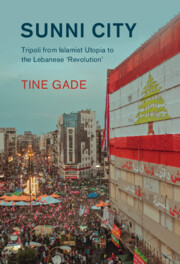Book contents
- Sunni City
- Cambridge Middle East Studies
- Sunni City
- Copyright page
- Contents
- Figures
- Acknowledgements
- Who Is Who in Tripoli?
- Timeline of Major Events
- Note on Arabic Transliteration
- Introduction
- 1 Tripoli’s City Corporatism and Identity Politics during the Nationalist Era (1920–1979)
- 2 Regional Proxy War
- 3 The Postwar Erosion of Tripoli’s City Corporatism
- 4 The Globalization of Islam and the Crisis of Religious Authority
- 5 The Future Movement
- 6 Tripoli’s Islamists
- 7 The Impact of the Syrian Civil War and Beyond (2011–2020)
- Conclusion
- Bibliography
- Index
- Books in the Series
Introduction
Tripoli, Secondary City of Lebanon
Published online by Cambridge University Press: 10 November 2022
- Sunni City
- Cambridge Middle East Studies
- Sunni City
- Copyright page
- Contents
- Figures
- Acknowledgements
- Who Is Who in Tripoli?
- Timeline of Major Events
- Note on Arabic Transliteration
- Introduction
- 1 Tripoli’s City Corporatism and Identity Politics during the Nationalist Era (1920–1979)
- 2 Regional Proxy War
- 3 The Postwar Erosion of Tripoli’s City Corporatism
- 4 The Globalization of Islam and the Crisis of Religious Authority
- 5 The Future Movement
- 6 Tripoli’s Islamists
- 7 The Impact of the Syrian Civil War and Beyond (2011–2020)
- Conclusion
- Bibliography
- Index
- Books in the Series
Summary
Tripoli, October 2019: Young people from various religious backgrounds and all walks of life sang and danced together in the city’s central al-Nour Square, shattering the myth of Tripoli as a ‘cradle of terrorism’ or ‘citadel of Muslims’. The Islamists who had often dominated Tripoli’s urban space retreated, and youths, families, and members of the educated middle class filled al-Nour Square during Lebanon’s revolutionary moment.
Why and how did Tripoli become the country’s prime centre of contentious politics in otherwise-peripheral Lebanon?
The introduction presents the main argument of the book, introducing the concepts of the dethronement of secondary cities, politics of autochthony, and erosion of city corporatism in Tripoli. It then discusses the broader lessons of the Tripoli case, which speak to three strands of literature: studies of Lebanon and the Levant; discussions on sectarianization in the Middle East; and debates on the ‘Sunni Crisis’ in the Middle East. Lastly, the research methods used for data collection are presented.
Keywords
- Type
- Chapter
- Information
- Sunni CityTripoli from Islamist Utopia to the Lebanese ‘Revolution', pp. 1 - 27Publisher: Cambridge University PressPrint publication year: 2022

